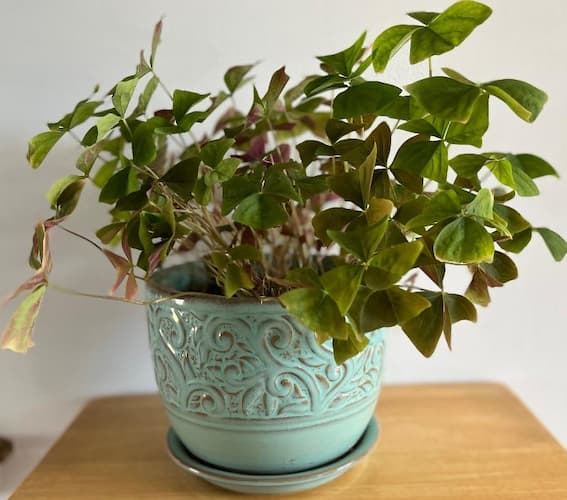How to Grow Clover Plants Indoors as a Houseplant

About Growing Clover Plants Indoors
You may not want clover growing in your lawn. But, growing them in your home is another matter. Clover houseplants are shade-tolerant and very easy to grow indoors. Indoors in a flowerpot, they are attractive, too. The plants have both medicinal and culinary uses. And, you never know, when growing clovers indoors, you just might find a lucky four-leaf clover on the plant. How lucky is that!?
Did you Know? All parts of the clover plant are edible. So, if you get hungry, just cut off a few leaves and chow down. Snack time, anyone!?
These tender annuals can be grown from seed or cuttings. They like sunshine but tolerate shade very well, making them a great indoor houseplants. To grow their best, the plants need rich, soft soil that drains well.

Medicinal and Culinary Uses of Clover
As you sit in your family room on a cold and snowy winter’s day, you look upon your Clover plant sitting in a flowerpot on an end table. The sight of it just might make you a little hungry. All parts of the plants are edible, either raw or cooked. The leaves are used in salads and soups. It adds color to foods. The flowers have a slightly sweet taste. Try it tonight!
This plant has medical benefits, too. Make clover tea to fight fever. It helps to cleanse wastes from the lymph system and improves blood. It can help to avoid or ease upset stomachs. And, it provides cancer protection as well as helps to lower cholesterol. So, add a little clover to your diet and live healthier.
Did You Know? Many homeowners apply herbicides to eliminate clover and other weeds from their lawn. Yet some homeowners add it to the lawn as it is a hardy plant that stays green under most drought conditions. And more than a few homeowners and landscapers install a clover lawn!
Clover Houseplant Specifics
Flower Colors: White, red, pink, or purple flowers, depending upon variety.
Flowers Bloom: Indoors intermittently at varying times.
Plant height: Usually 3 to 6 inches tall. However, they can grow up to 8 inches tall.
Light Requirements: Levels vary. From full sunlight to partial shade and indirect light.
Soil Ph: 6.0 – 7.0
Toxic?: No. The plants are safe for humans, pets, and other animals.
Edible?: Yes.
Deer Resistant? Yes.
Number of Species: Over 300.
Plant Hardiness Zones: 3 – 10
Native To: Europe and Central Asia.
Plant Type: Perennial
Botanical Name: Trifolium Repens
Is Clover Edible?
YES!!
Welcome to the world of edible weeds! It is perfectly safe for humans, pets, farm animals, and wildlife.
The flowers, leaves, stems, and tiny seeds are all edible. Use them raw or cooked. They have a mild and sweet flavor. Use clover plants in soups, salads, and even as a topping for your loaded baked potato. Also, try it in teas, and as an herb.
Medicinal Applications for Clover Plants
A four leaf clover is not the only lucky thing about this versatile plant. It also has a wide variety of medicinal applications. Red clover is primarily used medicinally. Here are some of the medical applications:
- It improves cardiovascular health.
- Arthritis treatment.
- Clover is used in some cases to treat cancer.
- It is a treatment for respiratory ailments, including Asthma and Whooping Cough.
- Use it to treat symptoms of menopause.
- Support and strengthen the immune system.
- Fight Osteoporosis.
Light Requirements
For indoor-grown clover Houseplants:
Give the plant bright indirect sunlight. Rotate the plant every several days, to give light to all of the leaves.
For Clover grown Outdoors:
Just ask anyone who has clover growing in their lawn. They will tell you clover grows in almost any light level except full shade. The plants grow well in full sunlight. Also, they are tolerant of partial shade and even bright, indirect light.
Clover Houseplant Propagation
The plants are propagated from seeds and through the spreading of their stolons (root offshoots). As any homeowner with a lawn knows, clover is an invasive plant. Existing plants spread rapidly, if unchecked.
For use as a houseplant, most people buy clover plants at a local garden store.
Did You Know? One plant produces between 14,000 to 350,000 seeds. And, the tiny seeds remain viable in the soil for up to 14 to 20 years. That’s one of the resaons why clover is so hard to keep out of your lawn.
Clover Houseplant Care and Maintenance
Growing clover plants indoors is easy. They are a low-maintenance plant. And, you just might find a lucky four-leaf clover among the leaves.
Clover plants grow best in full sun. However, they are shade tolerant and survive with as little as 4 – 5 hours of sunlight. As a result, they usually thrive indoors.
Plant them in a flowerpot that has a drainage hole and saucer on the bottom. Use indoor potting soil. Water the plants thoroughly when planting them.
Allow the top of the soil to dry between watering. Clover houseplants do not like wet soils. As a drought-tolerant plant, they need less water than many plants.
Like other indoor houseplants, do not add a lot of fertilizer. You want indoor plants to grow healthy, but slowly. Add a liquid fertilizer every other month. Or, use houseplant fertilizer spikes which provide timed release of nutrients for your plant. DO NOT use both at the same time.
Clover plants tolerate crowding. However, you can transplant them into a larger flowerpot, if they begin to look too crowded.
Ideal Soil pH: 6.0 – 7.0
Pruning Clover Houseplants
No trimming is needed.
Remove dead and dying leaves. A small number of dying leaves is normal over time. but, don’t worry. New leaves will soon take their place. If a lot of leaves are dying or drooping, the soil is probably too wet.
Clover Houseplant Problems
Clover is a tough plant and suffers few problems.
Spider mites can be an occasional problem. Use insecticidal soap as, as needed.
As previously mentioned, Plant drooping is usually caused by overwatering. Allow the soil to dry out and watch the leaves bounce back.
Plant disease is uncommon.
Clover Trivia
Here’s a little clover trivia to help make you the expert on this subject:
- Four leaf clover is very rare! It is estimated that only 1 in 10,000 clover leaves are four-leaved.
- The four leaves stand for faith, hope, love, and luck.
- One plant produces between 14,000 to 350,000 seeds.
- The seeds remain viable in the soil for up to 14 to 20 years.
- Seed companies once included clover in grass seed mixtures.
- Only one in 10,000 leaves are four-leaved.
- The Irish word for clover is “Shamrock”.
- Shamrocks are not the national symbol of Ireland. Surprisingly, it is the harp.
- Clover is native to Europe. But, it has spread its roots all over the world.
- All parts of the plant are edible. There are dozens of clover recipes online.
- It makes a great houseplant.
Related Articles
Also, people who read this article will like:
World Find a Four Leaf Clover Day
How to Grow Houseplants – Indoor plant care
Please support our site. Shop for:
- rmmatthews100@hotmail.com
- 585-721-6528
- Rochester, NY
©1999-2024 GardenersNet.Com, All Rights Reserved

